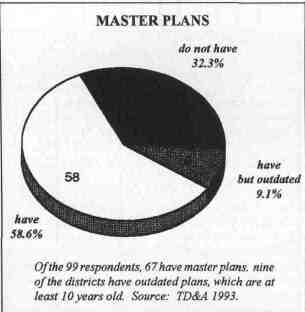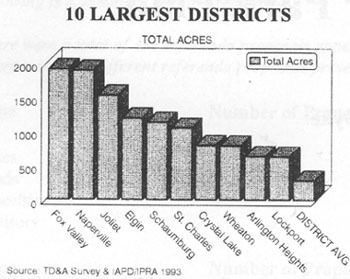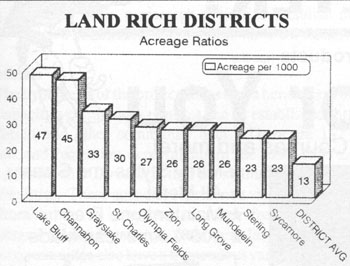|
Bond Referenda
and the Master Park Plan
by Peter T. Dyke
|
Introduction
Park district management has struggled with the thought
and reality of tax caps imposed by the Property Tax Extension
Limitation Act of 1991. The Act has severely limited park
districts' ability to finance needed improvements and the prospect of Cook County districts facing the same situation as the
collar county agencies remains in the foreground.
The primary tool for planning for and dealing with effective
management of the larger park district issues remains the Open
Space Master Plan. The Open Space Master Plan has withstood
the test of time as the main vehicle for planning, managing and
shaping open space and recreation in United States communities. In fact, two-thirds of Illinois districts and park departments have a Master Plan to help manage their jurisdictions effectively. |

|
In preparation for this article, TD&A conducted a detailed
survey of 127 Illinois park districts and recreation departments
to confirm vital information. The results were extraordinary;
76% of the districts responded to our request for information.
Thanks to all who responded and a special thank you to the IAPD
and IPRA for sharing their data.
Referendum and Tax Cap Legislation
The issue, with respect to the tax cap issue, is important to
explore. First and foremost, it is important to realize that we in
the park community have a good chance of living with the tax
caps instead of living without caps. The legislature in Springfield is not likely to back down on the issue. If we are to live with
caps, then we must plan for caps.
As you all know, park districts obtain funds from several
sources, including:
1. Existing Tax Levy. How the district manages existing
levy funds will continue to remain a priority. We can assume levy
proceeds will remain relatively constant with inflation.
2. Public Participation. User fees, fund raising for specific
projects and revenue producing assets such as golf courses,
driving ranges and concessions, will become higher profile
revenue sources.
3. Bonds. The importance of referenda will become even
greater, and the ability of park boards to "position" their
referenda correctly will become even more crucial. The districts'
ability to convince voters that their ideas and plans are wise will
become paramount to successful park management.
In each revenue producing category above, a master plan
allows the management of the funds to be directed in a prudent
and responsible manner because of the knowledge obtained and
guidance provided by the plan. The Illinois Department of
Conservation routinely asks districts whether or not they have a
master plan when funds are requested.
|
Illinois Parks and Recreation
|
15
|
July/August 1993
|
|
Master Plan Purpose
Park officials are responsible to the citizens of their jurisdictions to make the best possible decisions based on sound facts and accepted standards. In order that the facts are readily available
and coordinated with one another, a Master Park Plan in text and
map form is necessary to compile and organize all important
information. The future of each community is fragile and crucial
for all residents; therefore, informed decisions are vital.
Planning Process
One of the principal objectives in pursuing the development
of a new or updated Master Plan is the establishment of a
"process" whereby the park agency, advisory committee, staff
and private citizens are all involved. The process will produce
a "blueprint" for the future. This blueprint consists of maps,
charts, statistics, plans, goals, standards, cost estimates, priorities, phasing written recommendations and an implementation
strategy. The process works to coalesce public opinion so that
local governmental leaders can work toward common goals
which serve the entire community. It is vital to each plan that
the board and staff work to help shape the document when
preparing the plan. The implementation stage is the most
successful if the final plan contains the results of hard work and
input of both the board and staff members.
|

Nine of the top ten largest districts, measured by
total acres, have master plans, and two out of three
districts (66 out of 99 respondents) have prepared
master plans to help manage their districts. Note:
Peoria and Rockford, two large districts, are not
included in the survey results.
|
A good Master Park and Open Space Plan should have a
"Purpose" Section which not only describes the reasons for the
plan being prepared but also contains a history of the park
agency, its general philosophy and current policies. Not all park
agencies are alike nor are they created for the same purpose.
Each may have different state statutes under which they are
legally obliged to operate.
Existing Conditions and Community Involvement
Once the preparation of the Master Plan is underway, it is
important to undertake a comprehensive inventory of the existing facilities which are under the jurisdiction of the park agency. An important aspect of the inventory is an assessment of
compliance with the Americans with Disabilities Act and the
Consumer Product Safety Commission Guidelines. When prioritizing park upgrades, in relation to other capital improvements, the district's degree of compliance to national standards and
laws is important to document. Population data should be
gathered on the residents in the jurisdiction of the park agency,
and an analysis of the population should be undertaken with a
population projection made for a 10 to 20 year period.
A recreational attitude and interest survey is just as important. Such a survey may be 100% sample or, in large jurisdictions,
may reach only a percentage of the population. The purpose of
the survey is to find out which facilities people use, what they
want, and whether they are willing to pay for upgrades through
increased taxes or user fees. A study of recreational programming should then be undertaken. This portion of the Master Plan should document the growth and changes in recreational programming and assess the impact that possible population shifts will produce in the way of changing demands on the facilities,
staff and existing programs.
|
Goals and Standards
Once the status of physical facilities, recreational programming, staff requirements and desires of the community residents
has been determined, the identified requirements should be
converted into new policies measured against appropriate standards. The National Recreation and Park Association published park standards in 1983. The current standard for park acreage
per 1,000 residents is 10 acres. We believe that the standard
should be raised to 15 in suburban areas to reflect social changes,
citizen needs and attitudes. The "per 1,000" common denominator is useful in articles such as this so comparisons can readily
be made. A set of goals and objectives needs to be written
outlining what the agency should strive to achieve. The goals
should include standards for the amount of park land the agency
should have, and minimum standards should be set for needed
programs. |
|
DISTRICT COMPARISON
|
|
District
|
Acreage
per 1000
|
Acreage
|
Sites
|
Residents
|
EAV
|
|
Wheaton
|
15.7
|
797
|
47
|
50,800
|
$911,148,548
|
|
Gurnee
|
13
|
195
|
11
|
15,000
|
$315,638,767
|
|
Wilmette
|
12.4
|
330
|
24
|
26,690
|
$540,861,878
|
|
Burr Ridge
|
11
|
75
|
14
|
6,800
|
$233,640,232
|
|
Glenview
|
10.1
|
482
|
37
|
47,540
|
$914,548,897
|
|
|
Illinois Parks and Recreation
|
16
|
July/August 1993
|
The standards are often accompanied by the preparation of
charts and typical park designs to illustrate how the physical
elements of the system can best be interrelated. At this stage, an
important step to remember is the consideration of joint usage of
public property owned by another governmental agency. Intergovernmental agreements are often written in contract form,
such as the park-school situation where the school district owns
the land or buildings but permits park usage during non-school
hours. Another important step is to make a comparison of agency
owned and managed property and facilities with regional and
national standards. Often an agency will undertake the preparation of a Master Plan and not relate the plan to nationally
accepted standards. This can result in a failure to provide needed
and wanted facilities.
|
Capabilities and Constraints
The evaluation and analysis of the agency's physical, financial and management capabilities and constraints is a crucial
next step. This includes an objective evaluation of all park
facilities to determine park conditions and usefulness within the
entire system. A similar evaluation should be made of the
agency's financial resources, as determined by its existing tax
rate, potential tax rate, assessed valuation, bonded indebtedness
and future financial capability. The tax cap legislation has made
this section of the plan even more critical now than in past years.
A similar study includes an objective look a the current management of the agency to determine its capability to meet the
challenges of the changing community. |

The districts above provide citizens with many
more acres per 1000 residents than the state
average. Lake Bluff boasts one golf course, 7 park
sites and 315 total acres for 6700 residents. Source:
TD&A and IAPD/IPRA, 1993.
|
Plans and Priorities
The Master Plan map graphically portrays the various
recommendations representing land acquisition, recommended
improvements and better utilization of existing facilities. The
plan should show the various types of parks, playgrounds and
open space facilities that are desired over a 10 to 20 year period.
Once the plan is graphically represented on a map, it is possible
to determine priorities for action. Many ideas on the plan will
take years to accomplish, but others require immediate action.
The plan specifically lists projects for the future, ranging in price
and scope from a new backstop to a 75 acre land purchase.
Financial Program
A Master Plan is a valuable tool by itself but becomes a
working document, interrelated with the annual budget, when a
financing program is prepared to accompany the plan. The
financing program or budget should express ways the plan can
be accomplished by including improvement projects in the
annual budget, bonding (utilizing governmental and non-governmental programs) and by intergovernmental cooperation. A
10-20 year spreadsheet is prepared showing the prioritized items
that are agreed upon by the board and the consultant. Estimated
costs are prepared and the projects are budgeted throughout the
10-20 years.
|
The Argument Against
In our consulting practice, we have heard arguments against
conducting open space master plans because of budget limitations. A common argument today is, "We cannot afford to spend money on 'soft' items like a plan that just sits on a shelf. We need
to spend money to upgrade parks."
A good Master Plan is one which is prepared by the
consultant with significant involvement of the director, staff and
park board. If the client is involved and has ownership of the
document through hard work, the plan will be implemented and
referenced instead of left "on the shelf." Districts find management of resources becomes easier and more efficient if a plan is
implemented and integrated into the capital budget. Districts
who use a plan find they could not afford not to have a Master
Plan. |
|
DISTRICT COMPARISON
|
|
|
Acreage
|
|
|
|
|
|
District
|
per 1000
|
Acreage
|
Sites
|
Residents
|
EAV
|
|
Wheaton
|
15.7
|
797
|
47
|
50,800
|
$911,148,548
|
|
Gurnee
|
13
|
195
|
11
|
15,000
|
$315,638,767
|
|
Wilmette
|
12.4
|
330
|
24
|
26,690
|
$540,861,878
|
|
Burr Ridge
|
11
|
75
|
14
|
6,800
|
$233,640.232
|
|
Glenview
|
10.1
|
482
|
37
|
47,540
|
$914,548,897
|
|
Golf related facilities are premium assets held by 44% of 97
survey respondents. Wheaton, Wilmette and Glenview all have
golf courses, but Burr Ridge and Gurnee do not. It is important
to recognize district's assets and the benefits of the different open
space types. Burr Ridge manages 437 acres and maintains 10.3
acres per 1000 residents. None of their acreage is tied up in a golf
course so they have more programmable land per 1000 people
than does Wilmette. Wilmette has 330 acres, but when the golf
course is backed out of the figure, their programmable acreage
|
Illinois Parks and Recreation
|
17
|
July/August 1993
|
figure is 8.5 per 1000.
|
Wise boards will recognize the
need to have current plans in place
before referenda issues are put before the voters. Referenda issues
should be raised by the planning
process. The planning process
should not be raised because of referenda issues. Voters will demand
completed master plans before referenda are voted upon. Voters will
expect board approved concept plans
for specific planned parks when being asked to vote for a referendum supported by the board. Board
members can say, "Look, we have this master plan that says ...
we need it and here is why...." |
"Referenda issues should be
raised by the planning process.
The planning process should
not be raised because of
referenda issues."
|
Summary
The many direct and indirect benefits of preparing a Master
Park and Open Space Plan include the following:
• A tool to help manage the district effectively and efficiently.
• New goals based on documented needs with specific
recommendations on how to achieve the goals.
• The establishment of a process whereby the community, staff
and agency officials agree on what
is important so they may continue to
act in the public interest.
• New policies and revised standards designed to implement the
goals.
• Basis for obtaining support
for referenda.
• Basis for obtaining IDOC
grants.
• Spin-off benefits, occurring
when an entire community recognizes that an agency is up-to-date and wants to plan a future for all to enjoy.
• A 10-20 year capital spending program tied to an operation
budget.
About the Author
Peter T. Dyke is a park planning consultant with Thompson
Dyke & Associates, Ltd. TD&A provides park planning and
design services for municipalities, school districts and park
districts throughout Illinois, Wisconsin and Indiana
|
Illinois Parks and Recreation
|
18
|
July/August 1993
|
|

